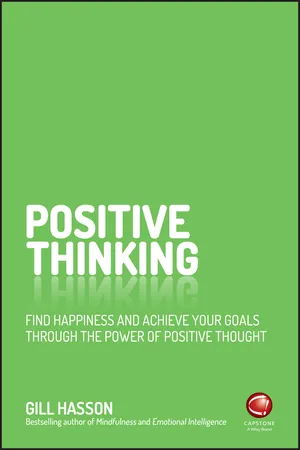
Positive Thinking
Find happiness and achieve your goals through the power of positive thought
- English
- ePUB (mobile friendly)
- Available on iOS & Android
Positive Thinking
Find happiness and achieve your goals through the power of positive thought
About This Book
Bestselling author Gill Hasson is back to help you learn how the power of positive thinking can change your life
Are you stuck in a rut? Do you feel plagued by negative thoughts and emotions every day? Gill Hasson, the bestselling author of Mindfulness and Emotional Intelligence, is back to help you move on from those pesky negative emotions and focus on the positive instead. Gill's practical and reassuring approach to the benefits of positive thinking will have you applying it to your own life every day.
If you struggle to see past setbacks both at work and at home, it can be tricky not to let those negative emotions affect you in every area of your life. This book will give readers the tools to view life with a positive outlook and charge ahead in achieving goals that once seemed out of reach.
Learn how to:
- Identify the triggers for negative thoughts and understand how to turn them into positive ones
- Deal with setbacks and make the most out of negative situations
- Improve your happiness by accepting situations and learning how to move forward
- Understand how the power of positive thinking can help you achieve your goals
The power of positive thinking is not a new idea; it's been around long enough to become almost a cliché, but there's a reason behind its longevity: positivity works. This book shows you how to break through the clouds today, and start working toward the life you want.
Frequently asked questions
Information
Part 1
Positive Thinking and Positive Action
1
You Are What You Think
Positive thinking vs. negative thinking
- Ask the other person to stand and extend their dominant arm out horizontally, at shoulder level so that their arm is parallel with the floor.
- Ask them to think of a time when they failed at something – a test or exam or job interview, for example. Then ask them to think negative thoughts about themselves: ‘I’m weak. I'm not as clever as other people. I'm hopeless. I'm pathetic, I'm not good at anything. I can't do this.'
- Ask the person to continue thinking the negative things. Tell them you are going to stand behind them and attempt to pull their dominant arm down to their side. Ask them to resist you pulling their arm down.
- Now, ask the person to hold their dominant arm up again at the shoulders, parallel to the floor.
- This time, ask them to think of a time when they achieved something, succeeded and did well at something – passed a test or exam, got offered the job, did well in a sport, for example. Then ask them to think of positive things about themselves: ‘I try my best. I can do well. I feel good about myself. I am a good person. I am strong. I can do this.’
- Ask them to repeat the positive statements to themselves while you attempt to pull their arm down to their side. Ask them to resist the pull.
Positive intentions of negative thinking
Narrow perspectives
Table of contents
- Cover
- Title Page
- Copyright
- Introduction
- Part 1: Positive Thinking and Positive Action
- 1: You Are What You Think
- 2: Moving on from Negative Thinking
- 3: Taking Positive Action
- Part 2: Developing and Maintaining Positive Thinking
- 4: Finding and Keeping Motivation
- 5: Creating a Positive Mindset
- 6: Building Your Self-Esteem and Confidence
- Part 3: Positive Thinking for Difficult Situations
- 7: Dealing with Disappointments and Setbacks, Trauma and Tragedy
- 8: Managing a Fear of Failure, Perfectionism and Comparing Yourself with Others
- Conclusion
- Useful Websites
- About the Author
- Index
- EULA